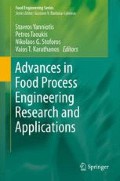Abstract
Food process design is concerned with the engineering design and economics of industrial food processes. Quantitative analysis of food processing operations requires material and energy (heat) balances on the process flowsheet. Equipment and energy (heat) requirements are calculated from rate equations of momentum (flow), heat, and mass transfer.
Process engineering calculations require the thermal and transport properties of foods, which are taken from the literature. Reliable values of thermal properties (specific heat and enthalpy changes) can be predicted from empirical correlations or taken from published data.
Transport properties (viscosity, thermal conductivity, and mass diffusivity) are strongly affected by the composition and physical structure of the food product, such as apparent density and porosity.
The rheological properties of fluid foods are affected by the size and concentration of the dissolved molecules or suspended particles. Temperature has a stronger effect on the viscosity of concentrated solutions, such as sugars, than on the apparent viscosity of suspensions.
Experimental data on thermal and mass diffusivity are essential. The thermal conductivity of solids decreases at higher porosities, while the opposite effect is observed with mass diffusivity. Temperature has a small effect on thermal conductivity, while mass diffusivity is affected strongly in nonporous and less in porous solids.
Heat and mass transfer coefficients in food process design are affected by the heat transfer medium, food material, and process equipment. Approximate values of the transfer coefficients are obtained from data in the literature and empirical correlations.
Access this chapter
Tax calculation will be finalised at checkout
Purchases are for personal use only
References
Boukouvalas CJ, Krokida MK, Maroulis ZB, Marinos-Kouris D (2006) Effect of material moisture content and temperature on the true density of foods. Int J Food Prop 9(1):109–125
Brodkey RS, Hershey HC (1988) Transport phenomena. A unified approach. McGraw-Hill, New York
Gekas V (1992) Transport properties of foods and biological materials. CRC Press, New York
Krokida MK, Maroulis ZB (1997) Effect of drying method on shrinkage and porosity. Drying Technol 15(10):2441–2458
Krokida MK, Maroulis ZB, Rahman MS (2001) A structural generic model to predict the effective thermal conductivity of granular materials. Drying Technol 19(9):2277–2290
Lazou AE, Michailidis PA, Thymi S, Krokida MK, Bisharat GI (2007) Structural properties of corn-legume based extrudates as a function of processing conditions and raw material characteristics. Int J Food Prop 10(4):721–738
Maroulis ZB, Saravacos GD (2003) Food process design. Marcel Dekker, New York
Michailidis PA, Krokida MK, Rahman MS (2009a) Data and models of density, shrinkage and porosity in food properties handbook, 2ed
Michailidis PA, Krokida MK, Bisharat GI, Marinos-Kouris D, Rahman MS (2009b) Measurement of density, shrinkage and porosity in food properties handbook, 2ed
Oikonomopoulou VP, Krokida MK, Karathanos VT (2011) Structural properties of freeze-dried rice. J Food Eng 107(2011):326–333
Rahman MS (1995) Food properties handbook. CRC Press, New York
Rahman MS, McCarthy OJ (1999) A classification of food properties. Int J Food Prop 2(2):93–99
Rao MA, Rizvi SSH, Datta AE (2005) Engineering properties of foods, 3rd edn. Taylor and Francis, New York
Reid RC, Prausnitz JM, Poling BE (1987) The physical properties of gases and liquids, 4th edn. McGraw-Hill, New York
Saravacos GD, Maroulis ZB (2002) Transport properties of foods. Marcel Dekker, New York
Saravacos GD, Maroulis ZB (2011) Food process engineering operations. CRC Press, New York
Zogzas NP, Maroulis ZB, Marinos-Kouris D (1994) Densities, shrinkage and porosity of some vegetables during air drying. Drying Technol 12(7):1653–1666
Author information
Authors and Affiliations
Corresponding author
Editor information
Editors and Affiliations
Rights and permissions
Copyright information
© 2013 Springer Science+Business Media New York
About this chapter
Cite this chapter
Krokida, M., Saravacos, G.D. (2013). Transport Properties in Food Process Design. In: Yanniotis, S., Taoukis, P., Stoforos, N., Karathanos, V. (eds) Advances in Food Process Engineering Research and Applications. Food Engineering Series. Springer, Boston, MA. https://doi.org/10.1007/978-1-4614-7906-2_7
Download citation
DOI: https://doi.org/10.1007/978-1-4614-7906-2_7
Published:
Publisher Name: Springer, Boston, MA
Print ISBN: 978-1-4614-7905-5
Online ISBN: 978-1-4614-7906-2
eBook Packages: Chemistry and Materials ScienceChemistry and Material Science (R0)

